[disclose]
The most visited Caribbean Island by far is the Dominican Republic. For most tourists, it probably starts and ends in the beach town of Punta Cana. However, there is much more to the Dominican Republic than just pristine beaches.
Preethi Chandrasekhar of The Eager Traveler recently visited the mountain region of Dominican Republic and here are her practical tips should you want to go explore more.
If you would like to write about your recent travel experiences on The Flight Deal, submit your pitch here.
=====
The Dominican Republic really does have it all! Before this year, all I knew of the DR was the pristine white sand beaches of Punta Cana. But on my recent visit, I had the opportunity to explore the central Cordillera mountain regions of Jarabacoa and Constanza – commonly known as the “Dominican Alps” and realized I had just experienced the heart and soul of this beautiful island.
The Caribbean is a somewhat daunting destination for those of us on the West Coast thanks to the distance. I flew from San Francisco to NYC (5 hours), and spent the night in Manhattan enjoying this fabulous city! I woke up refreshed and ready for the short 3.5 hour trip to the DR.
GETTING IN
If you’re from the East Coast, it’s an easy hop over from New York, Ft. Lauderdale, Miami, Philadelphia, San Juan, Atlanta or Charlotte. When you arrive into Santiago, you will need to pay 10 USD for a tourist card or you can purchase this in advance online. If you are flying a US carrier, the departure tax is included in the price of the airfare, so you will not have to pay anything when leaving the country. You can change your US Dollars and Euros to Dominican Pesos at the airport. The airport agents also speak English as well as Spanish.
CONNECTIVITY
The Dominican Republic actually was the second country in Latin America to have 4G wireless service and has a well-developed telecommunications infrastructure. Viva, Claro and Orange all have GSM plans and SIM cards so simply buy one of these SIM cards upon landing and voila you are connected. All our accommodations had WiFi and we encountered no problems. Don’t expect WiFi at restaurants, stores and on the beaches though.
MONEY MATTERS
The national currency is of course the Dominican peso but USD and Euros are also accepted at most sites, including taxis and restaurants which we found very convenient.
GETTING AROUND
Renting a car:
From the airport, renting a car and driving to Jarabacoa (about one hour from Santiago) is one option and the roads are good (watch out for large pot holes and over-sized speed bumps inside towns), which isn’t surprising as the Dominican Republic has Latin America’s third best transportation infrastructure. From Jarabacoa to Constanza, these roads are best navigated with a 4×4 vehicle so you may want to rent one from the airport for the duration of your trip. Driving is on the right hand side and the speed limit is 40mph in the cities and up to 100mph on the highways. I recommend driving through the country as it allows you to get to know the country and its people more intimately along the way. I loved being able to stop at a road-side fruit stall for plantains or to sample some local pork! A valid driver’s license and major credit card are required to rent a car for up to ninety days and the major car rental companies such as Alamo, Hertz, Avis and Budget, all have airport, hotel, and city locations. Car rentals can cost as little as $25 per day.
Bus:
If you don’t feel like driving, Caribe Tours is a great bus service with air conditioning that has connections to La Vega, from which you can continue on to Jarabacoa. This costs less than RD$10 and takes about two hours to get to Jarabacoa. The Metro is a deluxe bus service that has a slightly more upscale clientele. From Jarabacoa, the easiest way to get to Constanza is by taxi, which takes less than an hour and costs around RD$90.
FOOD AND DRINK
Staying in an Airbnb in Jarabacoa, we were able to have home-cooked breakfasts followed by lunch and dinner at restaurants in town. Jarabacoa has some really cute restaurants surrounding the Parque Central that also features a church, several bars, and colmados (mini-mart). Breakfast includes items like fried cheese, salami, fruit, eggs, sometimes avocados, and the local boiled mashed plantains (Mangu). Lunch usually consists of rice, beans, meat, sweet potato, ripe plantains, and fried plantains – which are delicious! Get a Presidente beer in one of the bars and people watch – my favorite pastime! For a fine dining experience, take the trip up to the Aoma De La Montana – do not miss this place. The location is fantastic, located at the top of a mountain with a sprawling view of Jarabacoa and the surrounding mountains. Yes, the floor rotates for a 360 degree view! The meat is fresh and succulent – the churrasco is definitely worth a try, while the Chivo a la Criolla (goat with a local sauce) is highly recommended.
ACCOMMODATIONS
We stayed at the lovely Jarabacoa Mountain Hostel – actually an Airbnb. Per person costs can range from $15-$25 per night. I know the word hostel might mislead some of you but don’t be fooled. I couldn’t believe this was an Airbnb! The hostel had two units, one that had a modern feel and the other a bit more rustic cabin vibe. Both units have plenty of bedrooms, their own living rooms/kitchen space, as well as beautiful outdoor patios to relax and unwind in. The bedrooms are spacious with spectacular bathrooms (with soaking tubs!) and some of the rooms come with balconies that provide a lovely view of nature. An added bonus are the dogs and a tiny kitten we quickly befriended whom kept us company in the evenings out in the patio. Not far from the hostel is the town, about a 10-minute walking distance, that makes for a great evening stroll if you want a taste of local cuisine, culture and scenery.
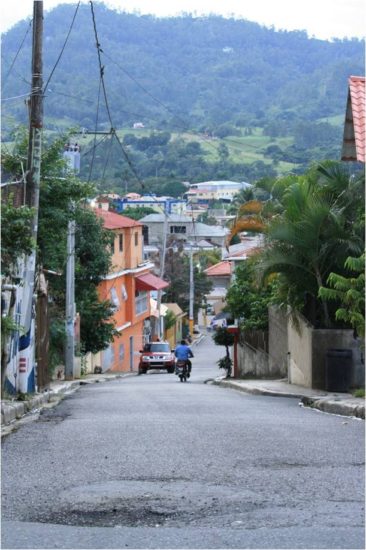
Jarabacoa town – Photo: (c) 2017 – Preethi Chandrasekhar of The Eager Traveler
ACTIVITIES
Rafting the Yaque Del Norte:
The name Jarabacoa translates to “Land of Waters” and is home to three rivers flowing nearby – one of which is the Yaque Del Norte, popular for its rapids. Staff at the Rancho Baiguate, can assist you with these rafting expeditions – I highly recommend them as they are professional and can provide you with a great experience from beginning to end. The rafting itself was an incredible adrenaline rush! The rapids go up to level 3, sometimes level 4, and have creative names like “Monica Lewinsky” and “the Toilet.” The guides are super friendly and good at making you feel comfortable! Afterwards, treat yourself to a buffet lunch at the Rancho Baiguate site after and even have a look around this beautiful place, home to many flowers and plants, including a butterfly farm. The weather in October is perfect as the water temperatures are cool to dip in, while the air outside is muggy. The rafting company provides a wet suit, helmet, and of course the rafts! The entire trip, including lunch, will cost you about 4 hours and $50.
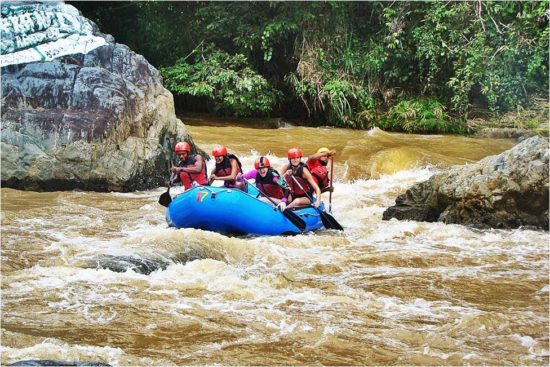
Rafting, Jarabacoa – Photo: (c) 2017 – Preethi Chandrasekhar of The Eager Traveler
Trekking the Pico Duarte:
Jarabacoa boasts the highest mountain peak in the Caribbean – the Pico Duarte. With a height of 3087 meters, this trek attracts around 3000 people a year who make the 2-5 day journey to the top. Day One of the hike usually goes from La Ciénaga to Compartición (18 kilometers [11 miles], up to 2,438 meters [8,000 feet] elevation); and Day Two, from Compartición to Pico Duarte and back. Mules are also an option when you get tired and wish someone would carry you the rest of the way up! The official rates for guides and mules per day are listed outside the Bermudez park office in La Cienaga. The park entrance fee is around $2.18, a guide can cost $17 per day and mules about $10. Don’t forget water, bug spray, and moisture wicking clothes to protect against the humidity.
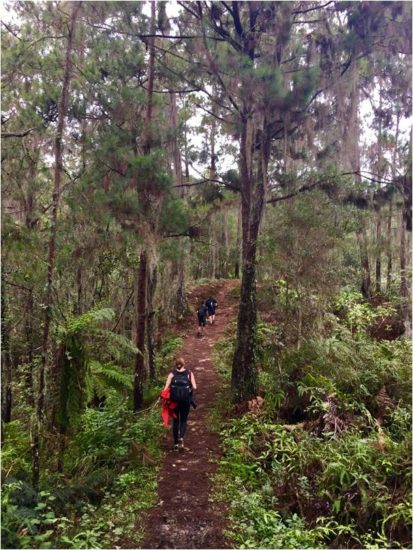
Pico Duarte, Jarabacoa – Photo: (c) 2017 – Preethi Chandrasekhar of The Eager Traveler
Hiking the Jimenoa Waterfalls (featured in Jurassic Park):
The town has many waterfalls, but the Jimenoa Waterfalls Uno is stunning and shares status with Jurassic Park as the opening scene was shot here. Now there are actually two waterfalls with the same name, hence this one is called #1. These falls, also known as the upper falls, approached from the west, off the Jarabacoa to Constanza road. The entrance fee is around $2.50 and young children are free. There is a gate at the steep entrance to the parking area off the highway. Just to the right of the gate is a little booth where they collect the fees. Swimming is permitted but the water is cold! It’s an easy 15-20 minute downhill hike through sometimes slippery patches of ground (if it has rained) that opens up into the stunning scenery pictured below. Beware, the hike back up can take 30 minutes and it’s very steep.
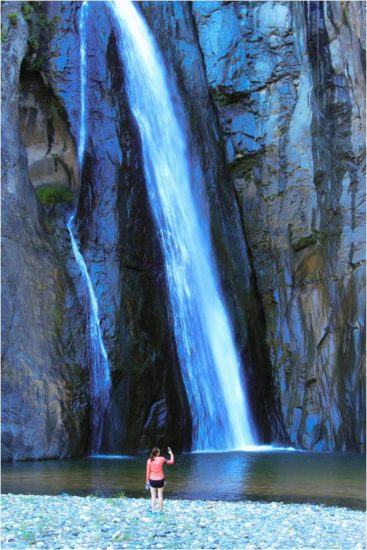
Jimenoa #1 Watefalls, Jarabacoa – Photo: (c) 2017 – Preethi Chandrasekhar of The Eager Traveler
Ebano Verde Science Reserve:
This is more than just an awesome place to hike. It’s also a place of research for scientists to understand more about the native plants found throughout the country. The Reserve has over 600 species of plants and flowers, and over 100 kinds of birds visible to you depending on the season. We chose one of the several hiking trails on the Reserve that culminates in a pool of waterfalls, called El Arroyazo. There is no cost of admission and this can be done right after the Jimenoa waterfalls hike.
Coffee Tour:
Coffee production is based mainly in these mountain regions, with the major coffee variety known as Arabica (mild). I loved taking a tour of Mr. Belarminio’s coffee company, which was started in 1943 by Belarminio Ramirez. Dedicated to the cultivation of coffee, the company owns 350 hectares of coffee production located in the mountains of the central range. The tour is educational and you can see each of the processes, starting from germination of grain to the final aromatic taste of the coffee. The company also has a small on-site cafe where you can buy various kinds of Monte Albo coffees!
Paragliding:
Want to fly like a bird? Paragliding is the sport for you! Flying Tony is a group of pilots, born and raised in Jarabacoa, who are enthusiastic about making this sport accessible to the public. It costs approximately around $50 to make a 15-25 minute flight over the lovely town and a pilot will accompany your flight, thank god! I felt very safe as we were harnessed into a “seat” that you share with your pilot (who handles the glider), managing the turns while up in the air, including skillfully landing down to the ground at the end of the flight. Gliding high up above the houses and the swimming pools, it’s a different world! I’m so glad I pushed past my boundaries and gave this a shot – it felt truly surreal and thrilling to fly and, most of all, I was proud I was able to overcome my fears of flying!
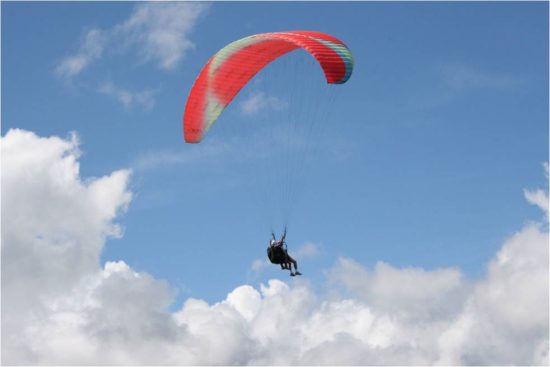
Paragliding, Jarabacoa – Photo: (c) 2017 – Preethi Chandrasekhar of The Eager Traveler
Constanza:
Welcome to the Switzerland of the Caribbean! At an average elevation of almost 4,000 feet, this town is surrounded by nature and bordered by four large national parks. The drive from Jarabacoa to Constanza is less than an hour and the road trip is absolutely breathtaking through the mountains. Constanza is a little hill station, cooler than Jarabacoa, so make sure you layer up, especially in the evenings. The temperatures range from 41-77 Fahrenheit and the winter months are December – March, when you can witness temperatures dropping into single digits at night, but the day continues to be moderately warm.
ACCOMMODATIONS:
You want to stay at the Hotel Alto Cerro in Constanza. Located on a slightly elevated hill, this hotel has a stunning view of the valley. Get a room with a balcony – twilight and early morning sunrise are worth it! The restaurant serves a good breakfast buffet, lunch and dinner. The hotel has 34 villas and 68 rooms, and there’s also a mini-market in case you need to buy snacks, etc. Altocerro also has a camping area, complete with a BBQ area, bathrooms, and a pool.
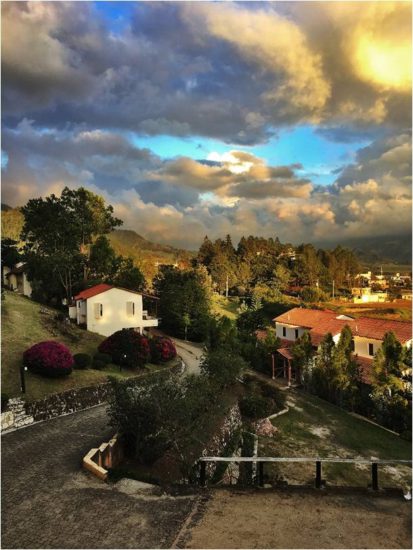
Alto Cerro, Constanza – Photo: (c) 2017 – Preethi Chandrasekhar of The Eager Traveler
Valle Nuevo National Park:
A visit to Valle Nuevo National Park is a must. It’s the highest alpine forest in the Caribbean, also referred to as “The Mother of the Waters” because over 400 rivers are born from its fertile soils. If you truly want to get off the map, spend a night at the Villa Pajon (on the way to the national park) – there is no internet, no electricity, no phone service. Can you handle it? The ride up to the national park in a small truck, covered on top but open at the sides, was a bone-jarring, adventurous ride thanks to the road conditions. You’ll see all sorts of interesting vegetation, including strawberry fields, and the cooler temperature is a pleasure away from the humidity of the city. As you approach the park, behold the small pyramids – four of them ordered by President Rafael Leonidas Trujillo to be built in the middle of the island and is supposed to mark the exact point that divides the island of Santo Domingo in half. Plenty of locals now camp here with tents to get in touch with nature and embrace the remoteness. A short distance away, we saw a monument that marks the places where Coronel Francisco Alberto Caamaño was killed during the 12-year rule of President Balaguer. If you have time, spend a night at Villa Pajon or camp to truly experience this park.
Cycling Tour:
Family Constanza cycling trail bike allows access to different plantation crops grown in the area and is a lovely way to explore the agriculture – after all, Constanza is the capital of industrialized agriculture. Get one of their 7-speed touring bikes that come with baskets and spend the morning cycling through little villages, meeting locals who will eagerly wave to you, and learn about the crops grown in this region. This was one of my favorite activities in Constanza!
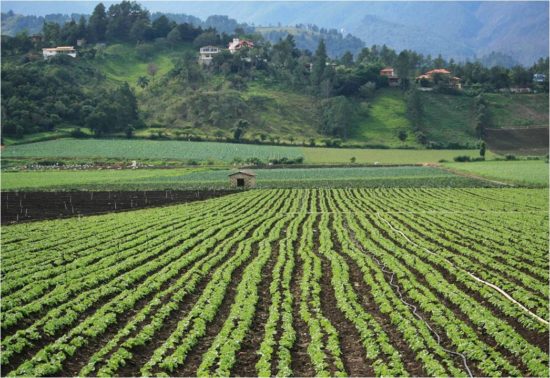
Cycling, Constanza – Photo: (c) 2017 – Preethi Chandrasekhar of The Eager Traveler
Jarabacoa may represent the wilder side of the Dominican Republic, but Constanza represents the heart of the country. To really experience Constanza, walk into town on a Friday or Saturday night and slip into any of the bars to listen to the beats of the Bachata or dance to the lively Merengue. Kapioca Bar and Moe Café Bar are the two popular nightspots in town. A visit to both towns will give you an immersive and experiential insight into the Dominican Republic, its people, culture and history. There’s a saying here in the mountains, “God is everywhere – but he lives in Constanza.” Now I know why.
About the Author:
Preethi Chandrasekhar is a freelance travel writer/influencer with a passion for sharing her travel stories to inspire people to explore more of this beautiful world. She’s interested in experiential travel and writes frequently about off the beaten path destinations. Follow her on Instagram and her blog, The Eager Traveler, for more of her travel pics and stories!
=====
To make sure you receive our latest deals, LIKE our The Flight Deal Facebook Page, follow us on Twitter @TheFlightDeal, Threads @TheFlightDeal or The Flight Deal WhatsApp channel or subscribe to The Flight Deal RSS Feed or Subscribe via Email (Once a Day)
The Flight Deal does not sell travel products or services. We provide you with information about third-party travel suppliers’ offers, and link you to their sites. The information posted by The Flight Deal is valid at the time of publication. However, we have no control over the suppliers, and we therefore do not warrant or guarantee that their offers will not change or become unavailable. Nor are we responsible for their products, services or site content. Please see their sites for their most up-to-date offer information and all applicable terms and conditions.
Sign up to receive The Flight Deal Daily DealsLetter, to stay up to date with the latest and greatest flight deals available.

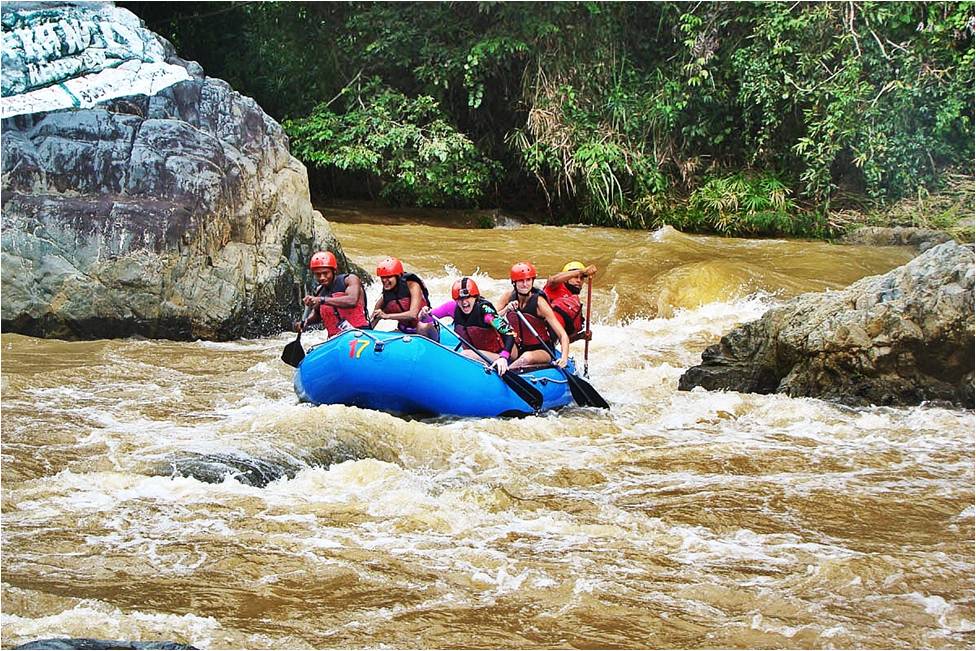
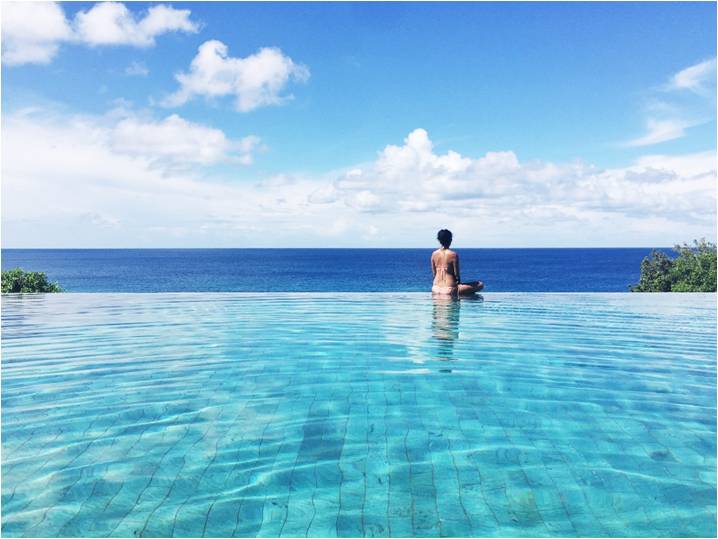
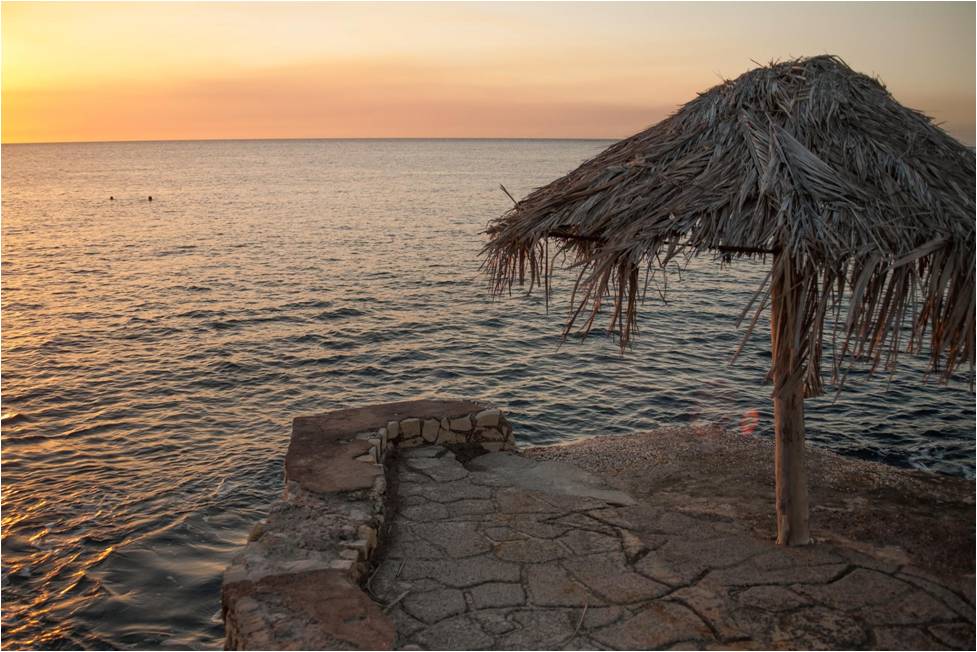
This is the best one I’ve read, by far. Well done!
Were you able to buy SIM cards at Santiago airport? I haven’t found them there in my past two times flying in.